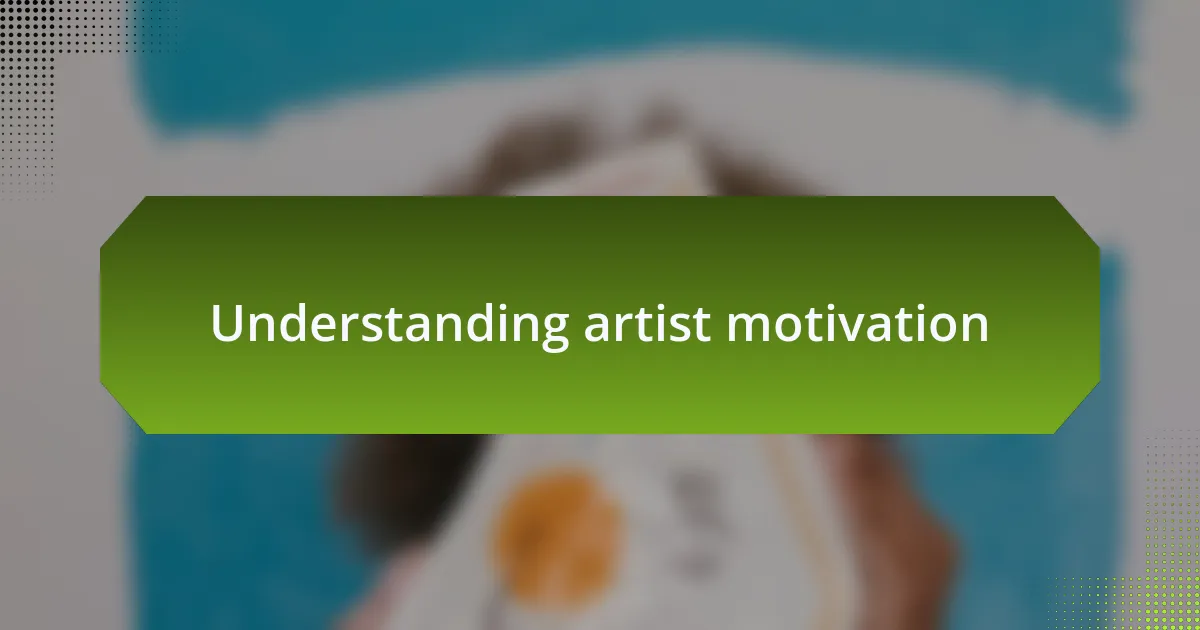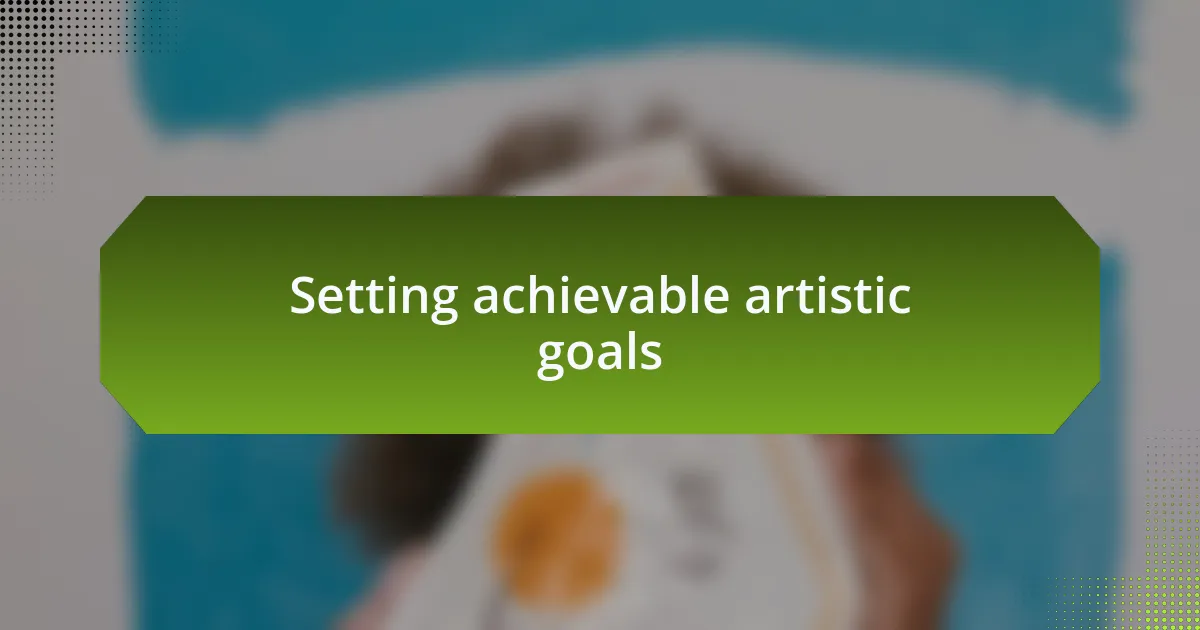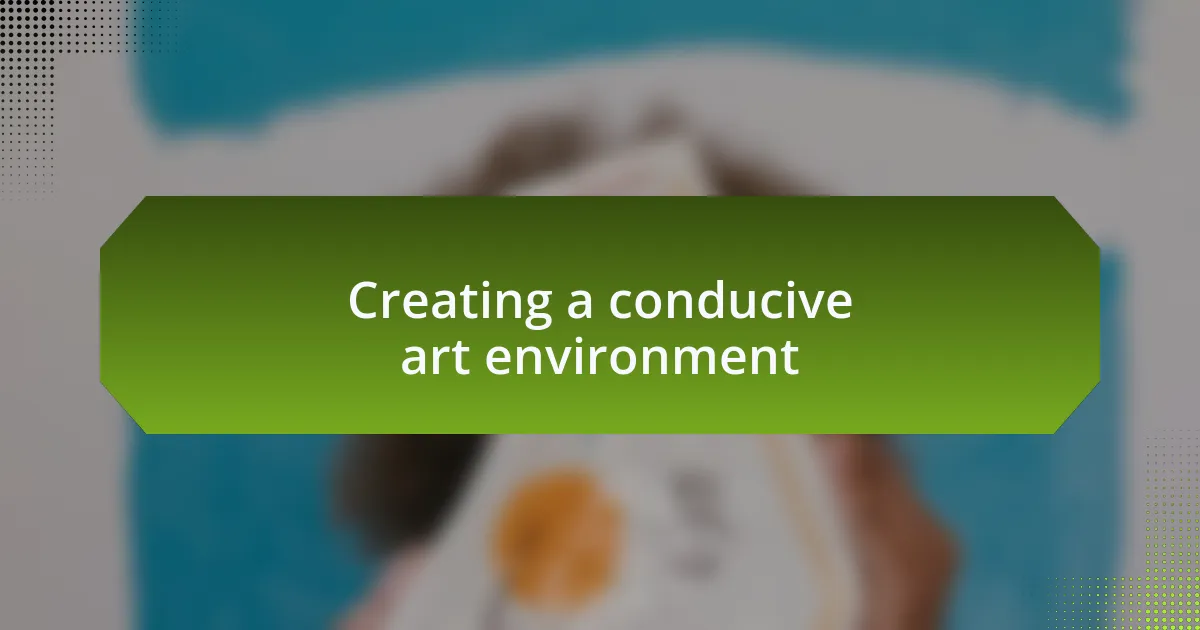Key takeaways:
- Artist motivation is a deeply personal journey influenced by external affirmation and life experiences.
- Engagement with the artistic community fosters ongoing inspiration and creativity.
- Setting achievable goals and creating a conducive environment enhances motivation and artistic flow.
- Seeking inspiration from other artists and their processes can reignite one’s own creative passion.

Understanding artist motivation
Understanding what drives an artist can be a journey filled with both struggle and exhilaration. I often find myself reflecting on the early days of my artistic career, when every brushstroke was a leap of faith. The passion that fueled my creativity was often tangled with self-doubt—do you ever feel that tension between inspiration and fear?
Motivation for artists is deeply personal and can stem from various sources, whether it’s a desire to express emotions, tell stories, or explore new techniques. I remember a particular moment when a friend viewed my work and exclaimed how my colors reminded her of a sunrise. That simple compliment reignited my creative spark and made me realize how interconnected we are through art. How often do we overlook the power of external affirmation in our motivation?
Moreover, the motivational landscape can shift drastically based on life experiences. I once faced a challenging period where life events dimmed my enthusiasm for creating. Yet, I discovered that revisiting old pieces or experimenting with different mediums could resurrect my drive. Have you found that certain experiences trigger a fresh wave of inspiration? It’s this ebb and flow of motivation that makes our artistic journey so dynamic.

Importance of motivation in art
Motivation in art acts as a catalyst for creativity, pushing artists to explore new horizons and techniques. I recall a time when I felt particularly uninspired by the blank canvas staring back at me. It was during a local art show that I met a fellow artist who shared her journey through struggle and triumph, reminding me how motivation fuels not just the individual, but the entire artistic community.
Without a steady stream of motivation, even the most passionate artist can find themselves stuck in a rut. I remember the frustration of working on a piece for weeks, only to feel it lacked the spark I desired. It was a simple outdoor sketching session that broke that cycle; surrounded by the vibrancy of nature, I felt my motivation surge again. Have you ever found that stepping outside your usual environment can rekindle your artistic fire?
This connection between motivation and artistic expression is essential. I’ve learned that my motivation often comes from the reactions of others—seeing how my work resonates with viewers transforms my creative process. How often do we underestimate the significance of that shared experience? Embracing this interdependence not only enriches my art but keeps me grounded in the joy of creating.

Strategies for maintaining artistic motivation
Finding ways to keep that artistic spark alive can be quite a journey. One strategy that has worked wonders for me is setting small, achievable goals. For instance, when I was painting a larger mural, I focused on completing one section at a time. This way, each completed chunk gave me a rush of accomplishment that fueled my desire to continue. Have you ever experienced that same uplifting feeling from small victories?
Another effective method is to regularly seek inspiration outside of my usual sources. I often find myself diving into art books or visiting different galleries, absorbing styles and ideas that invigorate my creativity. Recently, I wandered into a quaint local gallery and discovered a display of abstract sculptures that completely changed my perspective. How often do we underestimate the impact of diverse art forms on our own creativity? I believe this exposure can rejuvenate one’s artistic motivation significantly.
Lastly, I’ve found the power of community to be essential. Surrounding myself with fellow artists who share their challenges and triumphs fosters an ongoing dialogue that inspires me daily. I’ve participated in a monthly art meet-up where we critique each other’s work, which not only pushes me to improve but also injects a healthy dose of motivation. Have you established a supportive network? Because I can attest that this connection can make a meaningful difference in staying motivated.

Setting achievable artistic goals
Setting clear and achievable artistic goals is a game-changer for sustaining motivation. For example, I once decided to create a new piece every week for a month. This commitment not only kept my creative juices flowing but also helped me build a routine that felt manageable, rather than overwhelming. Have you ever noticed how a structured plan can alleviate the stress of starting from scratch?
Another experience I treasure was during a period of artistic block. I chose to map out my goals visually, breaking them down into specific, actionable tasks. I’d get a rush from checking off each step—like finally finishing that intricate detail on a canvas. This visual representation transformed my approach, proving that tangible milestones can make a world of difference in staying engaged with my work.
Moreover, I’ve learned the significance of aligning my goals with my personal interests. There was a time when I set out to explore various mediums, from watercolor to digital art. Focusing on what excites me rather than what I feel I “should” do revitalized my creativity. Have you ever asked yourself if your artistic goals truly resonate with your passions? Finding that connection can ignite a deep-seated motivation that propels your art forward.

Creating a conducive art environment
Creating a conducive art environment is essential for fostering creativity. I remember when I completely overhauled my studio; I removed clutter, swapped out harsh lighting for softer lamps, and added plants. The transformation was remarkable—suddenly, I felt more at ease, igniting a desire to create that I hadn’t experienced in a while. Have you considered how your space influences your creativity?
I’ve found that surrounding myself with inspiring artwork within my environment acts like fuel for my imagination. For instance, I dedicated a wall to display pieces from artists I admire, including my own work for motivation. Every time I glance at that wall, it reminds me of the power of creativity and pushes me to contribute something meaningful. What kind of inspirations are visible in your own space?
In addition to aesthetics, I realized the importance of sound and smell in my art space. I often play my favorite playlists or listen to ambient sounds while working, which captivates my mind. Likewise, I set the mood with essential oils—like lavender—to keep me tranquil yet focused. Isn’t it fascinating how sensory experiences can enhance our artistic flow?

Seeking inspiration from other artists
Seeking inspiration from other artists is something I deeply cherish. I often find myself exploring local art shows or online exhibitions, losing track of time as I immerse myself in diverse styles and interpretations. It’s intriguing how each artist’s unique perspective can provoke my own thinking. Have you ever felt a rush of motivation after seeing someone else’s work?
One memorable experience was when I attended a workshop led by an artist I admire. Watching them create in real-time stirred something inside me. Their process was so raw and authentic, making me realize that vulnerability is an essential part of art. It made me ponder—how often do we allow ourselves to be vulnerable in our own practice?
Additionally, I frequently browse artist interviews and documentaries. Hearing their stories of struggle and triumph often resonates with me. I remember one artist sharing how they transformed their pain into beauty, which inspired me to channel my emotions into my artwork. Isn’t it powerful to think that our experiences can connect us across different mediums and backgrounds?